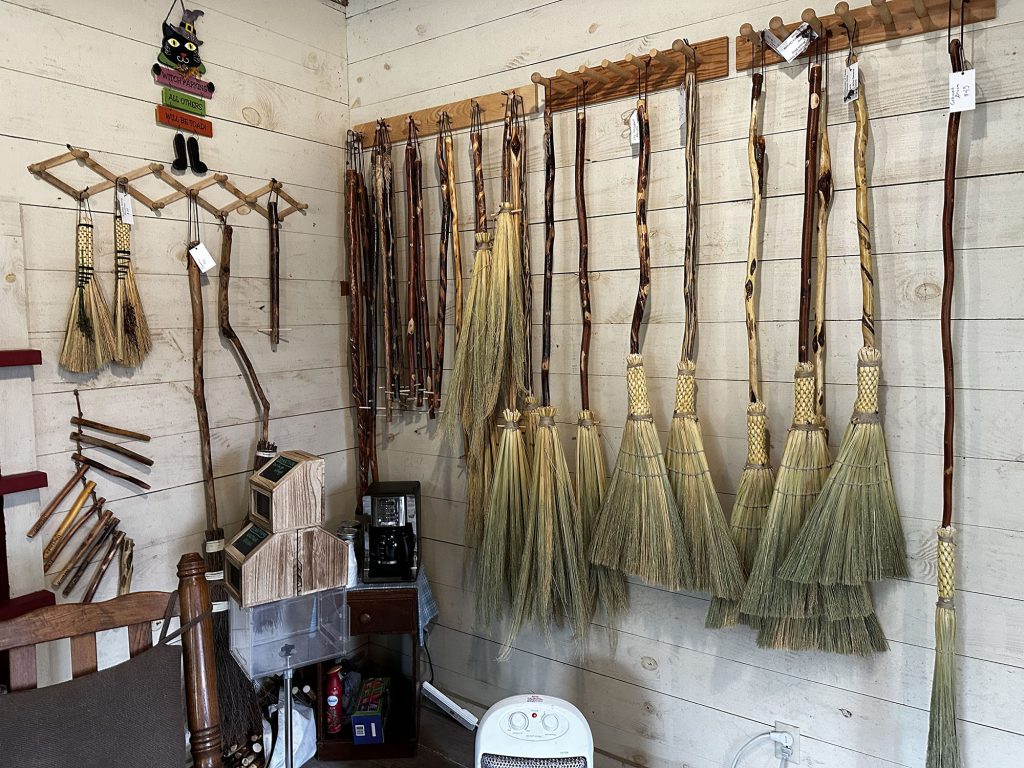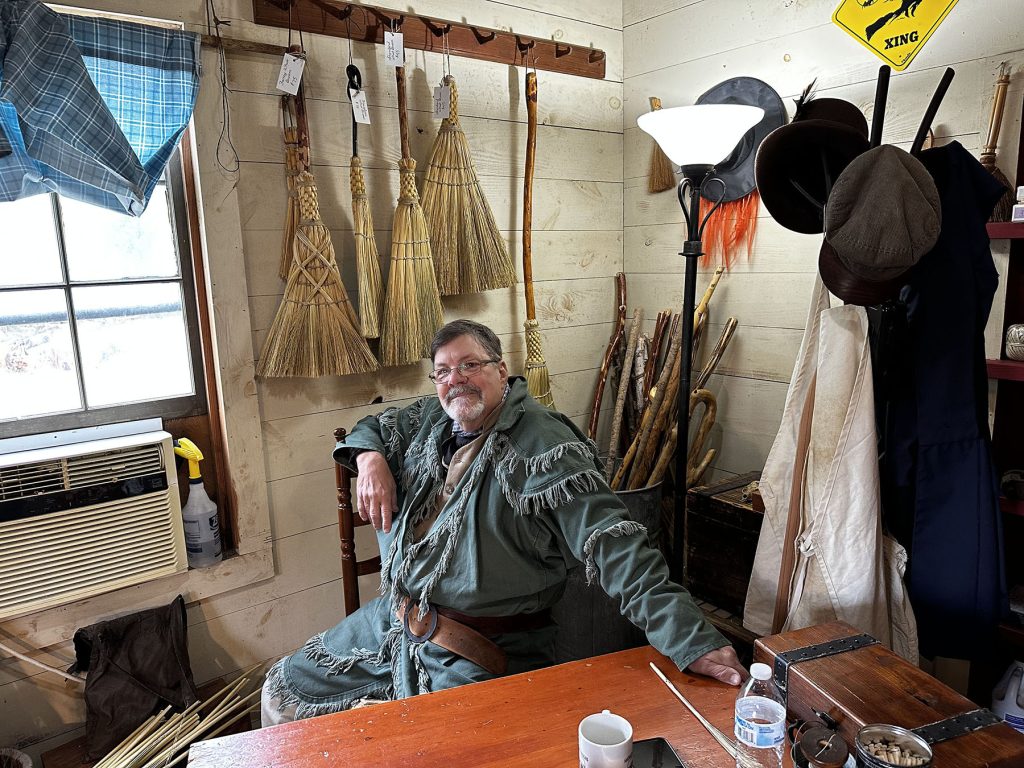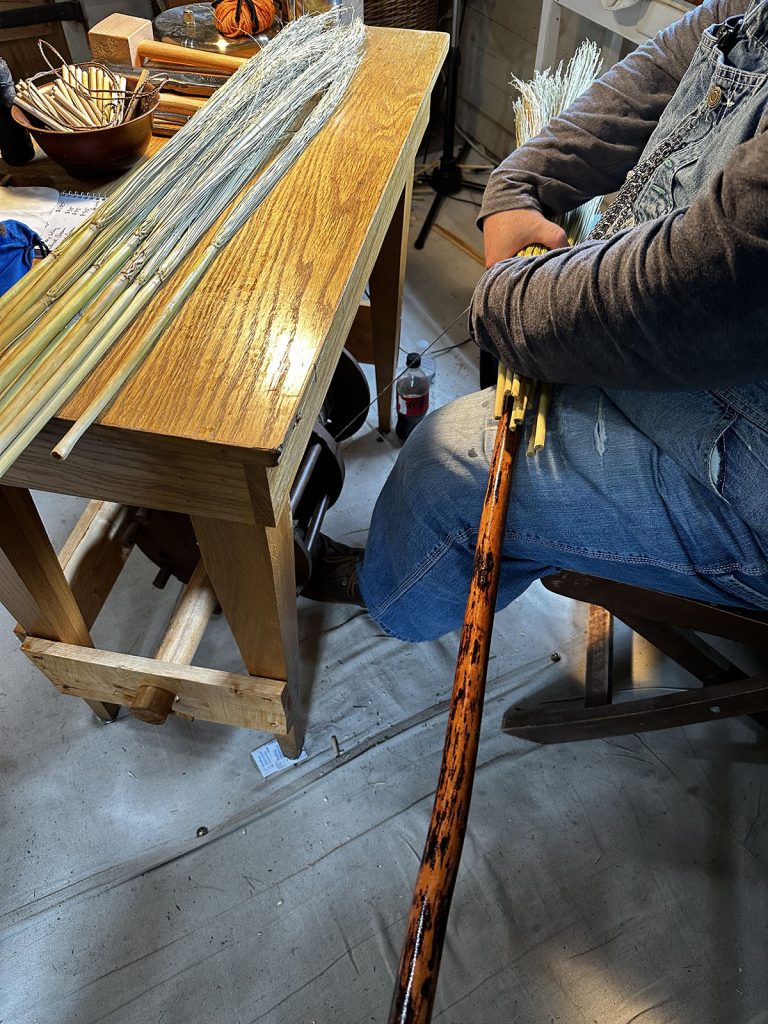
A wall displays the variety of brooms that can be found at the Republic of Texas Brooms and 1800’s General Store in New Braunfels. Photo by Omar Gallaga.
It’s wet and cool outside at Heritage Village in New Braunfels, but inside the limestone cottage where John Potter works, it’s cozy. And, importantly, well-swept.
Republic of Texas Brooms and 1800’s General Store
Address: Located in Heritage Village’s Museum of Handmade Furniture, 1370 Church Hill Drive in New Braunfels
Hours: Tues.-Sat. 1 p.m. to 4 p.m.
Admission: Adults, $8; kids under 12, free
Website: facebook.com/republicoftexasbrooms
Visitors to Heritage Village’s Museum of Handmade Furniture gather in a clump inside the cottage, which was built in 1848. Eight years ago, the cottage was turned over to John and his wife, Carol, to launch Republic of Texas Brooms and 1800’s General Store as part of the village’s living history exhibits. The couple’s love of Texas history goes beyond the store though: They got married in 2007 in front of The Alamo in 1830s period clothing.
Visitors, most from out of state, look at the brooms mounted on the walls of the cottage. Some are small and decorative; others are huge, with ornate carvings on the handles or with metal appropriate for fireplace sweeping.
Potter, wearing a green fringed tunic and large leather belt, runs the group through a history of brooms, from the pre-1750s “Besom” broom (basically twigs tied to a pole) to the flared “turkey-wing broom” associated with Benjamin Franklin, who was said to have favored the turkey as national bird instead of the eagle. (Franklin, apparently, also introduced broomcorn to the United States.)
The broom expert has been engaged in living history communities like this for 30 years and has been making brooms ever since he learned from a craftsman in Fort Davis about 15 years ago. It only took a few hours to learn the basic techniques, but over the years, Potter has studied a lot about the best materials and best practices to do it efficiently.

John Potter, owner of the Republic of Texas Brooms and 1800’s General Store, learned how to make brooms 15 years ago at Fort Davis.
Potter’s patter is also well-practiced—he’s got history, but he’s also got jokes that get a few laughs and chuckles from the tour group. “My name is Potter and I’ve got a lightning scar down the side of my head,” he says. “People expect my brooms to be magic, so we give flying lessons, too.”
Early brooms, Potter says, used to fall apart because of the way they were built. “If your mom’s chasing you and swatting you and the whole thing flies apart? That’s how we got the phrase, ‘Flying off the handle with someone.’” The crowd goes, “Ahhh!” (Online sources, though, suggest the phrase came from the tendency of axes to dangerously fly off their wooden handles.)

Brooms are made of hemp and can take two to three days to complete. Photo by Omar Gallaga.
Whether the patter is completely accurate or not, there’s no arguing with the quality of the brooms. Using a mix of original period and reproduced tools of the 1700s and 1800s such as a broom cutter and a broom press machine to hold twine tension, Potter and his apprentice of eight months, a retired athletic trainer named Jim Price, weave hemp stalks onto handles made of wood from trees including pecan, cedar, and Louisiana lilac.
Each broom takes about an hour of active labor to make, from gathering materials to plaiting, but because the hemp stalks need to be soaked so they don’t break and are then dried, the entire process lasts two to three days before a new broom is complete. The shop produces about 25 brooms a month.
They vary in price from about $35 to $75 for smaller brooms to as high as $150 for standard-size brooms (with handles about 38-42 inches) depending on the type of wood and whether they include metal. There’s even a cobweb broom that reaches vaulted ceilings up to 15-16 feet.
Potter stresses that although some of the brooms are nice enough to be hung up for decoration, these brooms are meant to be used, and they’ll last 15 to 20 years or more with care. “When we have someone come to buy one,” he says, “we always suggest they try them out first because each one sweeps a little different.”








